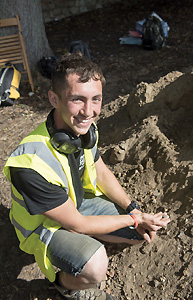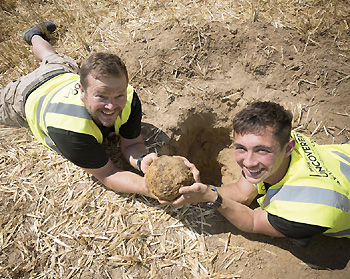|

Guardsman Oliver Horncastle with a Coldstream Guards officer’s tunic button found just inside the north
gate at Hougoumont |
This summer I attended an archaeological excavation, organised and led by Waterloo Uncovered, a ground-breaking charity working through the medium of archaeology and a love for history, to help wounded veterans and serving personnel with both physical and psychological injuries on their road to recovery. This was my chance to get to grips with the archaeology of one of the most famous battles in history.
Arriving at Waterloo, we were introduced to a team of internationally acclaimed experts and given a tour of the battlefield. Earmarked to be excavated were the sites at Hougoumont Farm and Mont-Saint-Jean, the allied field hospital that was the scene of grisly amputations and horrific injuries sustained at the hands of French cannon and musket fire. Briefings concluded, we were given a crash course in the basic principles and techniques of archaeology: how to excavate a trench, how to handle and record finds, and so on. Using a metal detector I had brought with me, I was let loose on the orchard around the field hospital to help with preliminary surveying. Having walked little more than a few feet, I unearthed the first of what were to be hundreds of musket balls across that part of the battlefield, showing just how close the fighting came to the field hospital.
Excavations well underway, I was then asked to join a team working at Hougoumont Farm, famously held by the Coldstream Guards against overwhelming odds. The walled farm complex was the site of fierce fighting when a French break-in party stormed through the rear gates. The Coldstream Guards (with help, as it turned out!) managed to close the gates, in Wellington’s words ‘turning the tide of battle’ in the Allies’ favour. Working under the supervision of archaeologist Phil Harding (famous from TV’s long-running Time Team series), I began by searching the spoil heaps from the newly-excavated trenches and could barely believe my eyes when a well-preserved Coldstream Guards button rolled out of the dirt to be seen for the first time since the battle. This find gave me an indescribable connection to the Regiment and the men who had fought and died to hold the farm. Over the next few days, further buttons were unearthed, including those from a Scots Guardsman, evidence that the Scots Guards were also involved in the action at the farm.

Guardsman Oliver Horncastle and a colleague with what turned out to be a French 6-inch howitzer shell discovered on the reverse slope of the ridge near Mont St Jean Farm |
Later in the dig we heard that human remains had been found outside the field hospital, identified as the amputated limbs of men wounded in the battle. Shattered bones and clean saw marks could be clearly seen marking where the cuts had been made and where the bones had been shattered by blunt trauma. Working alongside us on the project we had a number of amputees from recent conflicts like Afghanistan, who retold their experiences and provided a poignant and incredible link to what the victims of battle, both then and today, experienced.
As the project drew to a close, I and a team of metal detectorists conducted a survey of the field between Mont-Saint-Jean and the infamous ‘killing grounds’ where men of units like the Inniskilling Regiment of Foot held the line and were mown down by artillery. The aim of the survey was to try and establish the rough position of units during the battle by plotting where shot and shell were found on a map. I and a former Royal Marine were working together when we identified a signal deep below the ground. Digging through the sun-baked earth, we saw the unmistakable form of a cannon ball emerge. Not just any cannon ball; the lead archaeologist identified it as a 6-inch howitzer shell, packed full of black powder. It had been fired from Napoleon’s Grand Battery and would have struck terror into the heart of the men stood in square, a testament to their discipline and training. Still considered dangerous 200 years on, it was taken away by the Belgian Bomb Disposal team.
With that final discovery, the dig was over, and we returned to England not only empowered by the project but wiser, and with an open mind to new opportunities, careers and possibilities. I wish to extend my thanks to the charity and family that is Waterloo Uncovered.
Guardsman Oliver Horncastle
|
|


